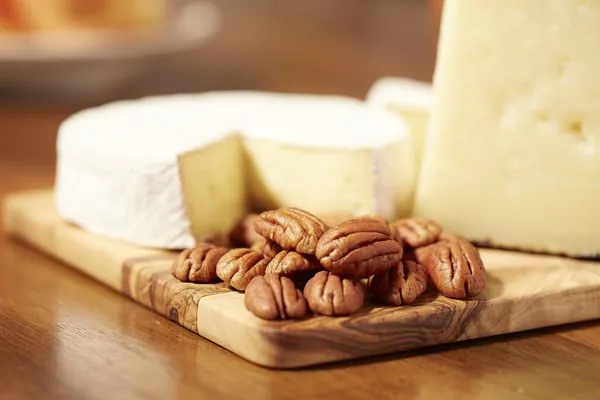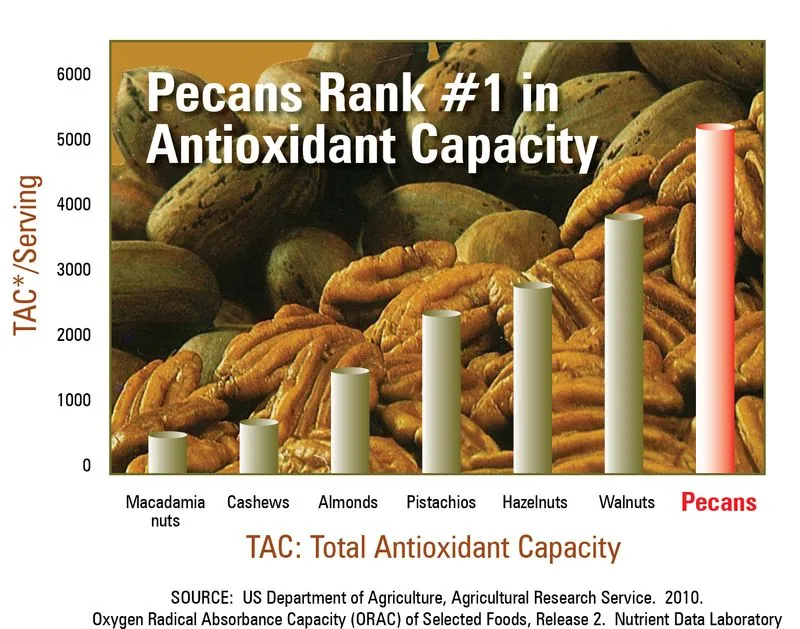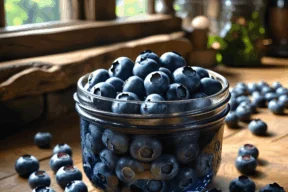Farm Facts That Feed You
Pecans Facts

Back
Fun Facts and Nutrition Notes about Pecans
Pecans: #1 in Antioxidants Among Nuts According to ORAC 1 Values

- Arizona’s Green Valley Pecan Company is the World’s largest irrigated pecan orchard.
- To produce fruit in half the time, farmers bud or graft seedlings onto established rootstock.
- Pecan trees are alternate bearing and have a good crop only every other year.
- It takes 78 pecans to make a pecan pie!
- Pecans are heart-healthy and contain 19 vitamins and minerals.
- Pecans are high in healthy unsaturated fat that can lower total blood cholesterol and preserve high-density lipoproteins (HDL) or “good” cholesterol. Sixty percent of the fats in pecans are monounsaturated and another 30 percent are polyunsaturated, leaving very little saturated fat in pecans. In addition, pecans contain no trans-fat.
- Pecans contain more than 19 vitamins and minerals – including vitamin A, vitamin E, folic acid, calcium, magnesium, phosphorus, potassium, several B vitamins and zinc.
- Pecans are naturally sodium free.
- A one-ounce serving provides 10% of the Daily Recommended Intake for fiber.
- Today, the U.S. produces about 80 percent of the world pecan supply. The top states, in order, are Georgia, New Mexico and Texas. Mexico is the top producer behind the U.S.
- A 2011 research study from Loma Linda University demonstrates that naturally occurring antioxidants in pecans may help contribute to heart health and disease prevention (January 2011 issue of The Journal of Nutrition). Eating pecans increased the amounts of antioxidants in the body and reduced “bad” cholesterol (LDL). More: http://ilovepecans.org/pr_20110111.html
- Today, “pecan” is pronounced many ways with strong differences in opinion inside of state and regional borders, even in the South. Webster’s offers three pronunciations: pi-ˈkän, pi-ˈkan and ˈpē-ˌkan
- Perhaps due to glaciation, pecans died out in Europe about 2 million years ago. The tree survived in North America and Mexico, however. Up until this year, most research says that the word pecan comes from the Algonquin Indians. According to new research from Andrew F. Smith, we don’t know whether “pecan” came from Natchez, Algonquin, or some other language. Whether it was a word commonly used among many Indian language groups is unknown. Request your free copy of the new paper by Andrew F. Smith from the National Pecan Shellers Association.
- About 1,000 pecan varieties exist, many of them named after Native American tribes.
- According to USDA July 2011 Pecan Crop Production Report, the 2010-2011 pecan harvest yielded 293,470,000 pounds of pecans. Estimates for the 2011-12 crop year suggest US orchards will produce 280,000,000 pounds of pecans.
- Before 1920, pecans were “hand-shelled” by consumers. In 1920, commercial shelling equipment made it much easier for us to enjoy these delicacies and consumption dramatically in the 1920s and after.
- According to National Pecan Shellers Association consumer research conducted in 2011: Pecan halves are the preferred form of the nut used in cooking and baking. When consumers think pecans, they most immediately associate the gems with pecan pie. (And who can blame them?) The pecan’s merits as a wholesome and convenient snack are just now starting to be discovered.
- Find story ideas, from how to improve your love life with pecans to tips on buying and storing: http://ilovepecans.org/story_ideas.html
- For pecan recipes visit http://www.ilovepecans.org/recipes.html
- For downloadable images, go to: http://www.ilovepecans.org/photo_library.html
Source: National Pecan Shellers Association at www.ilovepecans.org
1 Oxygen Radical Absorbance Capacity – a method of measuring the antioxidant capacity of foods and supplements developed by scientists at the National Institutes of Health.
Our Videos
View all VideosOur Latest Posts

The Scoop on Salt
For the longest time I never understood why every baking recipe always called for a teaspoon or two of salt, even if the baked good…

Training for Life’s Marathon: Fuel to Move, How Smart Nutrition Powers Everyone
This November, Tempe will once again become a stage for grit, perseverance, and pure human willpower as athletes dive into the waters, mount their bikes,…
Featured Recipes

Provided by: Garry Domingue, Rosie on the House Producer and Foodie












